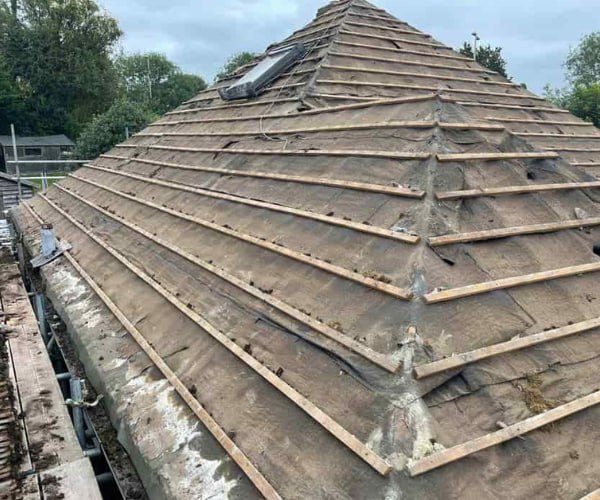How to Deal with Condensation on the Underside of Roofs
Condensation forming on the underside of a roof is a common but often misunderstood problem for homeowners. It’s not only unsightly — it can also lead to mould, damp, and even damage to the roof structure if ignored. Understanding why condensation happens and how to control it is essential to keeping your property dry and structurally sound. At BMT Roofing Wollaston, we’ve helped countless homeowners in Wollaston and across Northamptonshire resolve condensation issues before they develop into larger problems.
What Causes Condensation Under Roofs?
Condensation occurs when warm, moist air inside your home meets a cold surface, such as the underside of your roof. This is particularly common in loft spaces, garages, and outbuildings where ventilation is limited.
When air cools down, it can no longer hold as much moisture, and that moisture turns into water droplets. Over time, this can lead to timber rot, mould growth, and insulation damage — all of which can compromise the health of your roof.
Common Causes Include:
- Poor or inadequate ventilation in the loft or roof space.
- Warm air escaping from the living areas below.
- Damaged or missing vapour barriers.
- Blocked soffit vents or roof vents.
- Inadequate insulation causing uneven roof temperatures.
Understanding these causes is the first step in addressing the issue effectively.
The Importance of Ventilation
Proper airflow is the most effective way to combat condensation. Without it, moisture-laden air becomes trapped under the roof, increasing the likelihood of condensation forming.
At BMT Roofing Wollaston, we often find that older homes in Wollaston lack sufficient roof ventilation because building practices decades ago didn’t account for modern insulation standards. Adding or improving ventilation can make a significant difference.
Ways to Improve Roof Ventilation:
- Install soffit and ridge vents: These allow cool air to enter through the eaves and warm, moist air to escape at the ridge.
- Check existing vents: Ensure they are not blocked by insulation, debris, or paint.
- Add tile or slate vents: These are designed to blend into your roofline and provide discreet, effective ventilation.
Balanced ventilation ensures that air flows continuously through the roof space, preventing condensation from forming.
The Role of Insulation
Insulation is essential for maintaining an energy-efficient home, but it must be installed correctly. Poorly fitted insulation can trap warm air below the roof surface or block airflow entirely.
When insulation blocks vents or restricts air circulation, moisture becomes trapped — the perfect condition for condensation to form.
Key Tips for Effective Insulation:
- Keep a gap between insulation and the roof membrane for air circulation.
- Ensure insulation is dry and free from mould or damp patches.
- Avoid overfilling cavities — thicker insulation isn’t always better if it restricts airflow.
Our team at BMT Roofing Wollaston can assess your current insulation setup and recommend the best way to balance warmth with ventilation.
Vapour Barriers and Membranes
Modern roofing systems often include a vapour control layer (VCL) or breathable membrane. These materials play an important role in controlling moisture movement within your roof structure.
A vapour control layer stops warm, moist air from entering the roof space, while a breathable membrane allows trapped moisture to escape. Both are essential for maintaining a healthy, dry roof.
If your property is older or the existing membrane has degraded, condensation can build up rapidly. Replacing or upgrading these materials can significantly reduce the risk of future problems.
Regular Roof Maintenance Matters
Even the most well-designed roof can develop condensation issues if neglected. Routine maintenance helps ensure that ventilation points remain clear and your roof remains watertight.
At BMT Roofing Wollaston, we recommend checking your roof at least twice a year, ideally during spring and autumn, to prepare for seasonal changes in temperature and humidity.
During Maintenance, Check For:
- Blocked vents or soffits.
- Damp insulation or water-stained timbers.
- Leaks around flashing, chimneys, or valleys.
- Excessive moss or algae on tiles, which can hold moisture.
Early detection prevents minor issues from becoming expensive repairs later.
Condensation in Metal Roofs and Garages
While condensation is common in traditional tiled roofs, it’s especially noticeable in metal roofs used for garages, sheds, and outbuildings. Metal cools quickly, meaning condensation forms faster when warm air meets the cold surface.
Solutions Include:
- Adding anti-condensation coatings or membranes.
- Installing roof ventilation systems specifically designed for metal structures.
- Improving insulation under the roof to balance temperature differences.
Our specialists at BMT Roofing Wollaston are experienced in handling both residential and outbuilding roof condensation issues, providing tailored solutions that deliver long-term protection.
How a Professional Can Help
While small steps like increasing airflow can make a difference, persistent condensation often indicates a deeper problem — such as inadequate roofing materials or poor installation.
A professional inspection can pinpoint the source of moisture, assess insulation and ventilation quality, and recommend the most effective course of action.
At BMT Roofing Wollaston, we provide comprehensive roof assessments across Wollaston and Northamptonshire. Whether you’re dealing with light moisture or visible damp patches, our team ensures your roof is fully protected against condensation and related damage.
Conclusion
Condensation on the underside of your roof might seem harmless at first, but over time, it can cause serious structural and health problems. The key to prevention lies in proper ventilation, effective insulation, and regular maintenance.
If you’ve noticed damp timbers, mould, or moisture in your loft, don’t ignore it — professional intervention can save you from major repairs later.
At BMT Roofing Wollaston in Wollaston, Northamptonshire, we help homeowners eliminate condensation issues with expert roofing solutions designed for lasting protection. Whether you need improved ventilation, new membranes, or a complete assessment, our team is here to ensure your roof remains dry, durable, and dependable year-round.
Call us on: 01933 823 289
Click here to find out more about BMT Roofing Wollaston
Click here to complete our contact form and see how we can help with your roofing needs.

